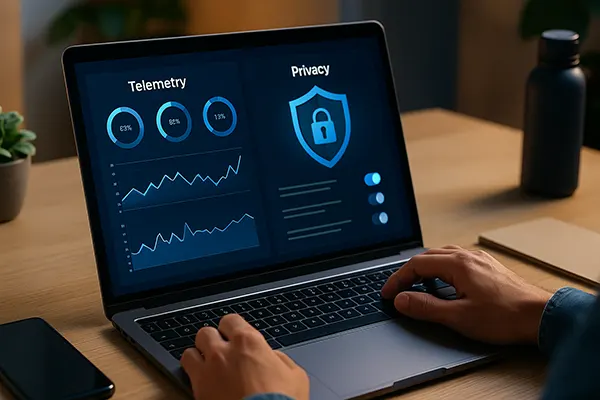PC Application Analytics: Is It Possible to Collect Telemetry Without Violating Privacy?

In 2025, the balance between software analytics and user privacy is under greater scrutiny than ever before. With increased public awareness of data protection laws, developers face the challenge of gathering meaningful insights while fully respecting users’ rights. Telemetry can be an invaluable tool for understanding application performance and user interaction patterns, but it must be implemented in a way that does not cross ethical or legal boundaries. The key lies in a transparent, privacy-first approach to data collection.
The Role of Telemetry in Modern PC Applications
Telemetry refers to the automated collection of data from an application to help developers understand its usage, performance, and potential issues. It is not inherently harmful; in fact, it often drives software improvements, quicker bug resolution, and better user experience. However, the scope and depth of data collected can determine whether telemetry becomes a useful development tool or a privacy concern.
Many modern PC applications use telemetry to measure application stability, track error reports, and monitor feature engagement. This helps software teams allocate resources efficiently and prioritise fixes or enhancements. The challenge is ensuring that no personal or sensitive user data is gathered without explicit consent.
In 2025, global regulations such as the GDPR in Europe, the UK Data Protection Act, and similar laws worldwide mean that collecting any identifiable information without user approval is not only unethical but also illegal. Telemetry must therefore be designed with privacy at its core, applying strict data minimisation principles.
Best Practices for Ethical Telemetry Implementation
First, anonymisation is essential. Collected telemetry data should never contain names, email addresses, or any identifiers that could link the information back to a specific user. Instead, it should focus on aggregated metrics, such as crash frequencies or load times.
Second, consent must be explicit. Users should be informed about what data will be collected, how it will be used, and how long it will be stored. They must also have the ability to opt in or out at any time. Transparent communication builds trust and ensures compliance with modern privacy laws.
Third, developers should regularly review and audit their telemetry systems. Removing unnecessary data collection points and updating privacy policies can help maintain compliance and prevent potential breaches. Independent audits can also reassure users that the application’s practices match its promises.
Privacy-Preserving Telemetry Technologies
New privacy-enhancing technologies make it easier to collect useful telemetry while safeguarding user data. Differential privacy, for instance, adds statistical noise to datasets, making it impossible to trace data back to individual users. This ensures insights remain valuable without exposing personal information.
Edge computing is another approach. Instead of sending raw data to central servers, analytics can be processed locally on the user’s device. Only anonymised summaries are then sent, significantly reducing the risk of data misuse.
Encrypted telemetry channels further protect data during transmission. In 2025, end-to-end encryption is considered a standard for any software collecting user metrics. Combining encryption with minimal data retention periods ensures that even in the event of a breach, sensitive information remains inaccessible.
Examples of Privacy-Focused Analytics in Practice
Several open-source projects have set strong examples for privacy-focused telemetry. Mozilla Firefox, for example, implements user-first data collection, clearly explaining telemetry purposes and allowing complete opt-out. Microsoft’s Visual Studio Code also offers transparent settings for adjusting or disabling telemetry collection entirely.
These models demonstrate that it is possible to collect valuable application usage data without compromising user trust. They highlight the benefits of proactive communication, robust encryption, and limited data retention policies.
Adopting similar practices allows developers to maintain transparency and respect user autonomy while still benefiting from the operational insights telemetry can provide.

The Future of Telemetry and Privacy
Looking ahead, the software industry is expected to face even stricter privacy requirements. Governments and regulators continue to introduce measures that limit the scope of data companies can collect, and users are becoming more selective about the applications they trust.
Developers who adopt privacy-first telemetry now will be better positioned to meet these evolving standards. Those who fail to adapt risk damaging their reputation, losing users, and facing legal consequences. In an environment where trust is a competitive advantage, ethical data collection is no longer optional.
Ultimately, the future of telemetry will depend on balancing transparency, user control, and technological innovation. By respecting privacy while leveraging advanced analytics, developers can create better software without undermining the very trust that makes their products successful.
Key Takeaways for Developers
Implement anonymisation and aggregation as default telemetry practices. Avoid collecting any personally identifiable information unless absolutely necessary and only with consent.
Provide clear, accessible explanations for what data is collected and why. Empower users to control their participation in telemetry through easy-to-use settings.
Invest in privacy-preserving technologies such as encryption, edge computing, and differential privacy. These tools allow valuable analytics without crossing ethical or legal boundaries.



